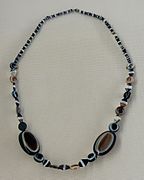Acropolis tomb
The Achaemenid Acropolis tomb was discovered by Jacques de Morgan during excavations on February 6, 1901 on the so-called Acropolis in Susa . It was a tub-shaped bronze sarcophagus that had not been robbed and contained a number of gold jewelry and other objects. It is one of the richest treasures from the Achaemenid period. The burial takes place in the middle to the end of the fourth century BC. Dated. It is the only known Achaemenid burial in Susa to date, although a similar but robbed sarcophagus was found nearby. Most of the finds are now in the Louvre .
description
The identity of the deceased is unknown. At first it was not certain whether a man or a woman was buried here. The absence of weapons, the small bones and the rich jewelry led the excavator to believe that a woman had been buried here. Because of the poor condition of her teeth, de Morgan suspected that she was old. But there are also evidence of rich jewelry gifts in men. Since the dead man was wearing a torque , it is now assumed that a man was buried here. Torques are not recorded as women's jewelry in the Achaemenid Empire.
The undecorated bronze tub was 56 cm high and 1.65 cm long. It probably once stood in a chamber with a vaulted ceiling. The arrangement of the finds in the tub can be easily reconstructed from a drawing by de Morgan and his excavation report. Two groups of objects can be distinguished. On the one hand there is jewelry that the dead person wore, on the other hand other objects have been deposited next to the dead person. All additions were found inside the tub.
The finds next to the corpse include a silver bowl and two alabastrons. Various chains lay on the chest of the dead man, some with gold elements, but also with pearls made of other materials. There was a golden torque around his neck. It is hollow and inlaid with lapis lazuli , mother-of-pearl and turquoise . Its ends each show a lion's head. Two solid bracelets are designed similarly, are made of the same materials and also show lion heads. They were each found on one arm of the dead man. Two round earrings are again made of gold with inlays of lapis lazuli, mother-of-pearl and turquoise. The function of different agate pearls has not been clarified. Today they are reconstructed as a chain, which was probably not the original function. They may have been sewn as ornaments on a piece of clothing. Two coins from the Phoenician city of Aruad date to the middle of the fourth century BC. And provide a dating reference to the grave.
gallery
Finds from the grave in the Louvre
literature
- Constantine Frank: The Acropolis tomb , in: Jean Perrot (Ed.): The Palace of Darius at Susa , London 2013, ISBN 9781848856219 , pp. 337–355
- Jacques de Morgan: Découverte d'une sépulture achéménide à Suse , in J. de Morgan et al, Recherches archéologiques: Deuxième serie , MDP 7, Paris, 1905, pp. 29–58 online .
Web links
Individual evidence
- ^ Françoise Tallon: Torque with Lion's-head Terminals , in: Prudence O. Harper, Joan Arux, Françoise Tallon (eds.): The Royal City of Susa , New York 1992, ISBN 0-87099-651-7 , p. 245 -246
- ^ Françoise Tallon: Beads , in: Prudence O. Harper, Joan Arux, Françoise Tallon (eds.): The Royal City of Susa , New York 1992, ISBN 0-87099-651-7 , pp. 249-250, no. 177 (Louvre Sb12070).
Coordinates: 32 ° 11 ′ 15 " N , 48 ° 14 ′ 51.4" E







